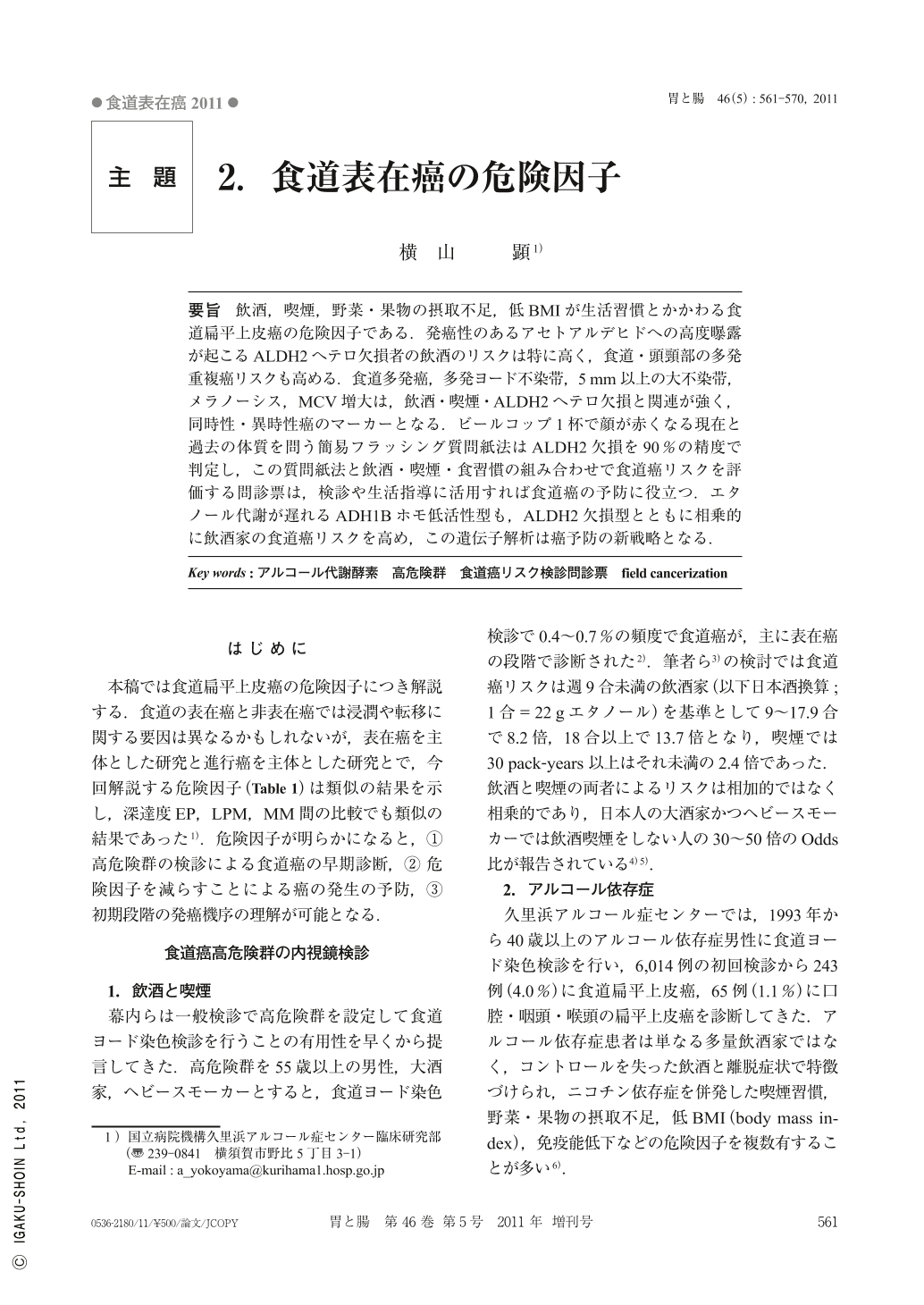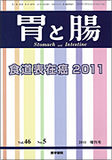Japanese
English
- 有料閲覧
- Abstract 文献概要
- 1ページ目 Look Inside
- 参考文献 Reference
- サイト内被引用 Cited by
要旨 飲酒,喫煙,野菜・果物の摂取不足,低BMIが生活習慣とかかわる食道扁平上皮癌の危険因子である.発癌性のあるアセトアルデヒドへの高度曝露が起こるALDH2へテロ欠損者の飲酒のリスクは特に高く,食道・頭頸部の多発重複癌リスクも高める.食道多発癌,多発ヨード不染帯,5mm以上の大不染帯,メラノーシス,MCV増大は,飲酒・喫煙・ALDH2へテロ欠損と関連が強く,同時性・異時性癌のマーカーとなる.ビールコップ1杯で顔が赤くなる現在と過去の体質を問う簡易フラッシング質問紙法はALDH2欠損を90%の精度で判定し,この質問紙法と飲酒・喫煙・食習慣の組み合わせで食道癌リスクを評価する問診票は,検診や生活指導に活用すれば食道癌の予防に役立つ.エタノール代謝が遅れるADH1Bホモ低活性型も,ALDH2欠損型とともに相乗的に飲酒家の食道癌リスクを高め,この遺伝子解析は癌予防の新戦略となる.
Alcohol consumption, tobacco smoking, low intake of green and yellow vegetables or fruit, and a low body mass index are risk factors for SCC(squamous cell carcinoma)of the esophagus. The ethanol and acetaldehyde associated with alcohol consumption are carcinogenic to humans(Group 1 carcinogens)and cause upper aerodigestive tract(UADT ; the esophagus and head and neck)cancer(WHO,IARC). ADH1B(alcohol dehydrogenase-1B)and ALDH2(aldehyde dehydrogenase-2)are major alcohol-metabolizing enzymes, and genetic polymorphisms of each modulate exposure levels to ethanol and acetaldehyde after drinking. The combination of alcohol consumption, tobacco smoking, the inactive heterozygous ALDH2*1/*2 and less-active homozygous ADH1B*1/*1 increase the risk of esophageal SCC in a multiplicative fashion. The magnitude of the ALDH2*1/*2- and ADH1B*1/*1-associated risk is larger in heavier drinking populations. A meta-analysis showed that ORs of ALDH2*1/*2 and ADH1B*1/*1=7.12 and 3.12 in heavy drinkers and 3.12 and 2.71 in moderate drinkers. ALDH2*1/*2 has a strong effect on the multiple cancerization in the UADT. Less-active ADH1B diminishes the intensity of alcohol flushing, thereby accounting for its great susceptibility to heavy drinking. Heavy drinking amplifies the modest effect of less-active ADH1B on ethanol elimination, leading to distinctly longer exposure of ethanol and acetaldehyde. The risk of esophageal SCC is extremely increased in a multiplicative fashion by the combination of less-active ADH1B*1/*1 and inactive ALDH2*1/*2 in Japanese drinkers(ORs=29~56). High red cell MCV(mean corpuscular volume), multiple or large esophageal dysplasia, and melanosis in the UADT, all of which are frequently found in ALDH2*1/*2 drinkers, are useful for identifying high-risk persons. A simple questionnaire asking about current and past facial flushing after drinking a glass(~180ml)of beer was found to be highly reliable in detecting inactive ALDH2 and predicting an individual's risk of esophageal SCC. A new health appraisal model that include facial flushing and drinking, smoking, and dietary habits is a powerful tool for devising a new strategy for prevention and screening for esophageal SCC in Japanese.

Copyright © 2011, Igaku-Shoin Ltd. All rights reserved.


